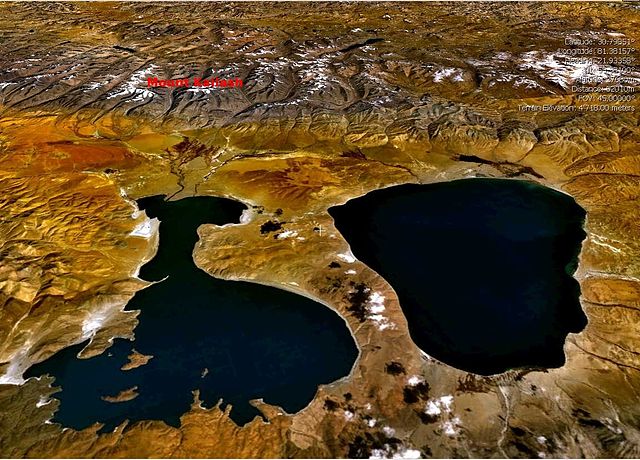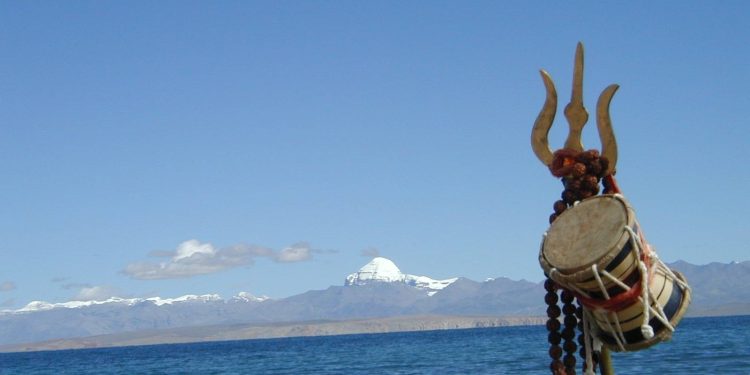Temple has believed that Devis Daksha Hasta fell at Manasa, where She is known as Dakshayani and Bhairava is called Amara.Shakti peeth Manasa is Located at Tibet. This Shakti peeth is placed just beside the purest and the most sacred water body specifically known as Lake Manas sarovar.
Shrine’s History
As per legend, Mount Kailash was discovered by king Gurlamandhata, after whom the highest Mt. Gurula (Mamonani) is named. At 22,027 ft, is said to have been formed 30 million years ago during the early stages of the formation of the Himalayan chain. In geological terms, Kailash stands alone, the worlds largest deposit of tertiary conglomerate. The Vishnu Purana (approx 200 BCE) described how the world is made up of seven continents ringed by seven oceans ? The central continent has Meru at its core, bounded by three mountain ranges to the north and three to the south. One of these ranges is the Himalayan barrier, interposed between Meru and Bharatha, the Indian subcontinent. Meru, the center, is Mount Kailash. Mount Kailash and Chiyu GompaMount Kailash has been one of the greatest mysteries for cartographers till about 1800. All they knew was that there stood a sacred mountain, an Asian Olympus of cosmic proportions. This mountain was said to be the navel of the earth and the axis of the universe and from its summit flowed a mighty river that fell into a lake, and then divided to form four of the great rivers of Asia.The earliest European record dates to 1715, from an Italian Jesuit called Ippolito Desideri, who passed Kailash on the way to Lhasa. John Rennell, the Father of Indian Geography, in his 1782 map of Hindustan, followed the Hindu belief that the Ganga had its fountainhead beyond the Himalaya at the sacred Manasarovar Lake, that the Ganga flowed south till the great chain of mount Himmaleh? and forced its way through a trans-Himalayan tunnel. It was only in 1812 when Hyder Jung Hearsey and Dr William Moorcroft crossed over the Niti Pass and surveyed the Manasarovar area that this geographical inaccuracy was corrected. Mount Kailash is situated in Tibet where it is given the dignified title of Kang Rampoche meaning Precious Jewel. Near Mount Kailash, during the geological shift in the initial stages of the formation of the Himalayan mountain chain four rivers arose from the area, flowing in four different directions : the Indus flowed north, the Karnali south, the Yarlung Tsangpo flowed east and Sutlej traveled west
Legends Associated with This Shrine
It is mentioned in the ancient scriptures that anyone who takes a dip in the holy Mansarovar Lake and circumambulates the peak, gets absolved of his or her sins for generations and attain salvation. The Kailash Manasarovar Lake is believed to have healing powers. Kailash Manasarovar Lake is believed to be the abode of the Hamsa or the Swan of Lord Brahma, one of the holy Trinity. The Lake is also considered to be one of the fifty-one Shakti Peethas where the Right hand of Goddess Sati fell to Earth after the Daksha Yagna episode of Hindu mythology.
The Goddess is worshiped here as Dakshayini. The site is extremely sacred to the Shakta sect of Hinduism. In the Vishnu Purana, a description of Mount Kailash states that the four sides of the peak are made up of Crystal, Ruby, Gold and Lapis-Lazuli (deep blue semi-precious antique stones).
The Mount Kailash is also known as the Axis Mundi of the World. This means that the Mount provides the connection between the physical world and the spiritual world. It is the axis around which the world has been created by the Gods. The visit to Mount Kailash peak is considered extremely sacred as it is situated near the sources of some of the longest and the holiest rivers that flow through Asia.
These rivers are Indus, Sutlej, Brahmaputra, and Apart from being considered as extremely sacred by Hindus as the abode of Lord Shiva and Goddess Parvati, the peak has significance in other religions too.
The Jains call the peak as Mount Ashtapada or the Meru Parvat, where the founder of Jainism and the first Tirthankara Rishabhadeva attained Moksha. The Buddhists consider the peak as the navel of the universe. It is also the home of the Buddha Demchok or Chakrasamvara, the representation of supreme bliss and harmony. The three hills rising from the peak are considered as the abodes of Bodhisattvas Manjushri, Vajrapani, and Avalokiteshwara. The Bon religious sect worships the peak as the abode of the sky Goddess Sipaimen. It is religiously believed that no one should step or climb the peak as it is considered a sin. It is claimed by locals that such ventures have ended up having tragic and disastrous consequences. It is believed that the stairways or the ridges on Mount Kailash lead to Heaven.
During the journey to Mount Kailash, one can also visit other holy peaks like Ravana Parvat, Hanuman Parvat, Padmasambhava, Manjushri, Vajradhara, Avalokiteshwara, Jambeyang, Shavari, and Norseng. These peaks are extremely sacred for the Buddhists.
In Buddhism, Lake Manasarovar is believed to be round shaped Sun representing Brightness and Good Nature? while the Lake Rakshastal which is crescent shaped represents Darkness and Evil?. The narrow connection named Ganga Chhu represents the small difference and the gray area between these two aspects of life.
The famed Gauri Kund or the Parvati Sarovar is located en route to Mount Kailash. This is believed to be the lake where Goddess Parvati gave birth to Lord Ganesha and made him stand as a guard while she was taking a bath. Lord Ganesha stopped Lord Shiva from meeting Parvati and in a fit of rage, Lord Shiva beheaded Ganesha. Distraught Parvati requested Lord Shiva to forgive Ganesha and bring him back to life. Lord Shiva replaced Ganeshas head with the head of a nearby elephant and since then, Ganesha came to be known as the Elephant headed God?.

Shrine’s Map Location and How to Go There
By Road
A limited number of Indian pilgrims are allowed to visit the Kailash Manasarovar every year.
They are monitored by the Indian and the Chinese Governments. There are two routes to reach Mount Kailash from the Indian side.
They are mentioned as below:
Route 1: The Lipulekh Pass Route The Yatra begins with a 3-4 day stay at Delhi. The tentative duration for the yatra would be 25 days with a cost of about 1.6 lakh per person.
Route 2: The Nathu La Pass Route The Yatra begins with a 3-4 day stay at Delhi. The duration of the yatra would be 23 days with the cost of 2 lakhs per person.
Apart from the Government conducted travel package, one can also book a private package that reaches Mount Kailash via Kathmandu, Nepal. This journey takes only 16-18 days to complete and is covered in jeeps. However, the cost, as well as safety, remains an issue as the packages are privately operated and do not come under the Government preview.
The path around Mount Kailash is 52 km long. The circumambulation is made in the clockwise direction by the Hindus and the Buddhists while in an anti-clockwise direction by the Jain and the Bon followers.
Extra Information About this Shrine
There is different explanation laid down by people with Hindu religion about the falling of a specific body part of Goddess sati at Shakti peeth Manasa. After various controversial talks, a group of prominent leaders have come to a conclusion that right palm of Devi sati has fallen down at shakti peeth Manasa. Since the idol of Devi have been provided with a different name at various shakti peeth, the name provided to this particular idol of devi is known as Dakshayani. Also the name given to Lord Shiva over here is known as Amar. This is one of the pure and religious spot of the whole earth where people can get all their desires fulfilled.














































